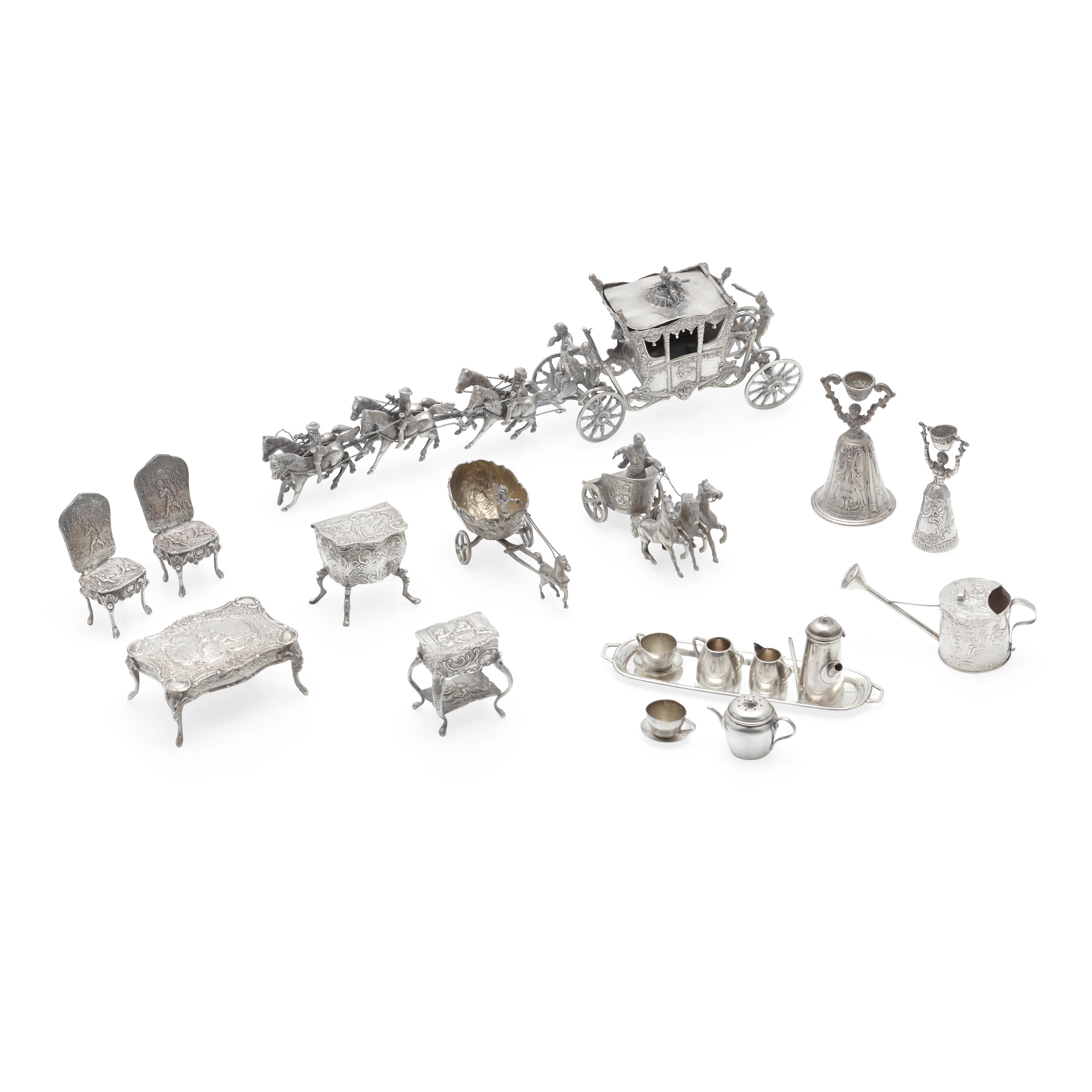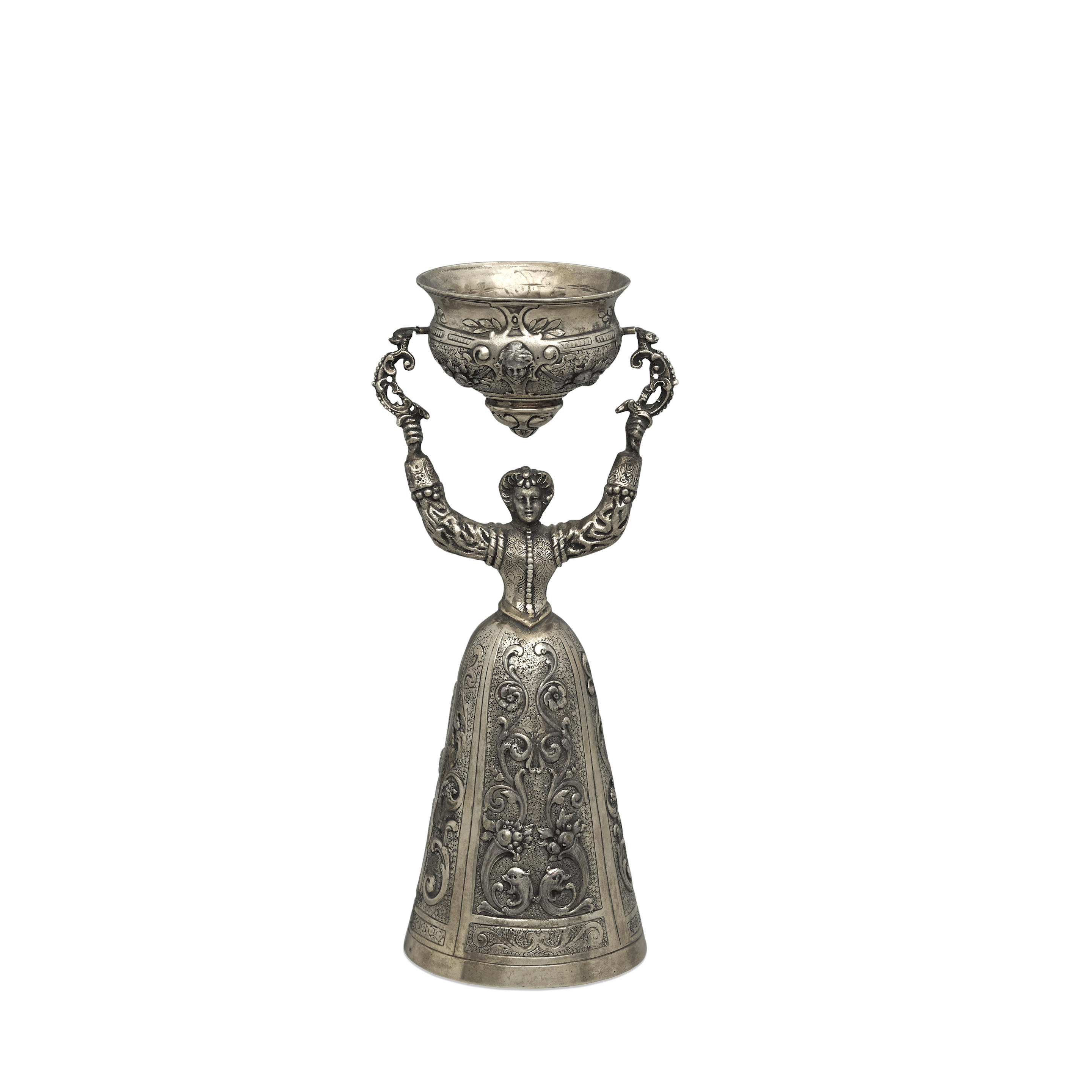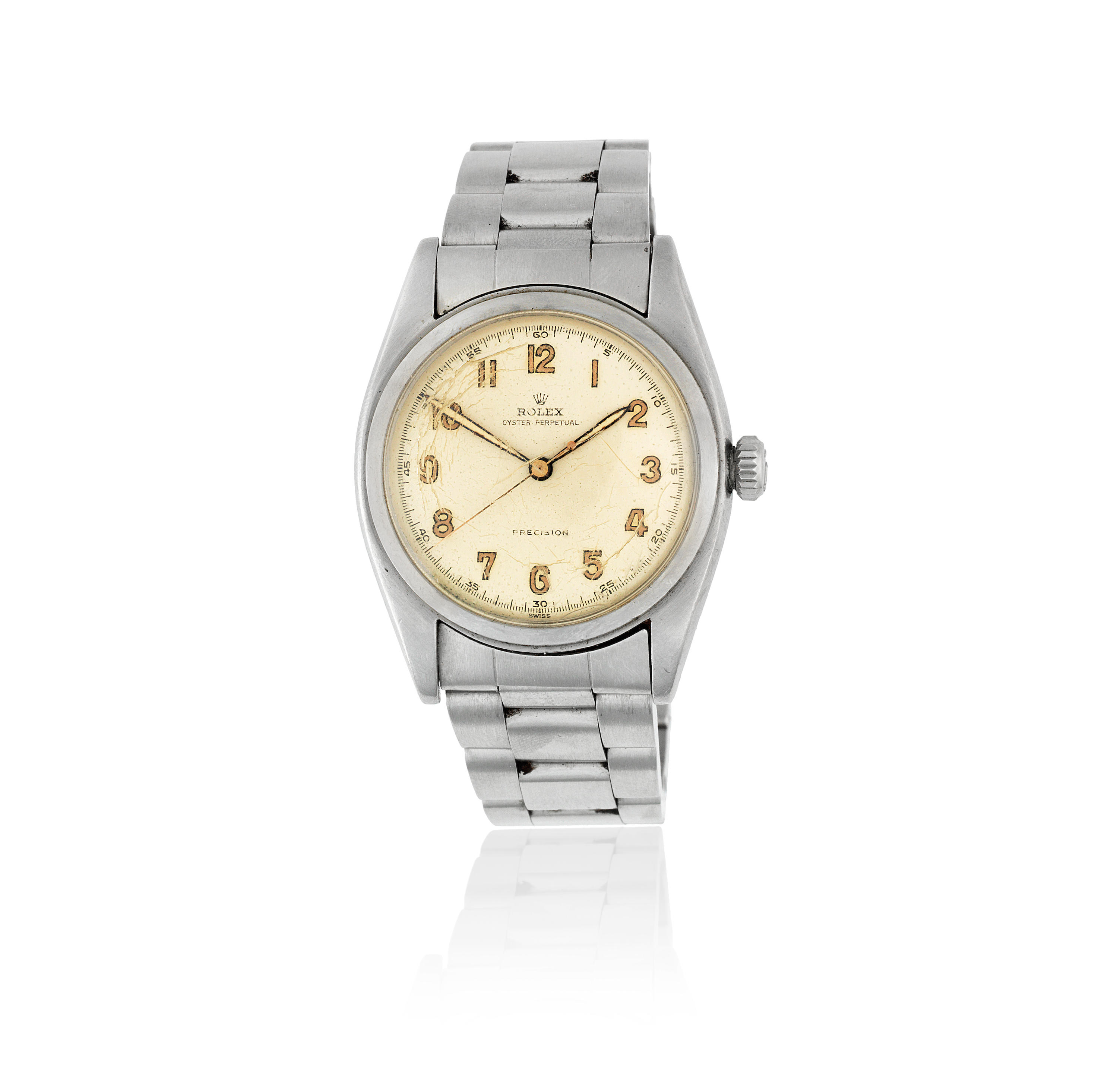A silver German wedding presentation charger, by Herbert Zeitner, 1930s, presented by Hermann Göring and his wife, the circular shallow dish of hammered finish, centred with an embossed panel depicting a naked maiden, holding armfuls of fruits including vines, pears and oranges, beneath a script inscription reading “Jum (?) 6 August 1936 Hermann und Emmy Göring”, the outer edge inscribed “WIE SICH ZUSAMMENREIMEN * NELKEN UND ROSMAREIN * WEINREBEN ZU RUSTBAUMEN * KOSTLICHE WURZ IM WEIN * SO SCHICKEN SICH ZUSAMMEN * EINMANN UND EHLICH WEIB * DIE WERDEN IN GOTTES NAMEN * EIN SINN EIN SEEL EIN LEIB”, ending in a twin heart motif, maker’s mark in circular punch and stamped ‘925’ the reverse mounted with a suspensory loop, diameter 37cm. £3,000-£5000 Condition Report The charger is in good condition, light surface wear only. Hallmarks are clear. Weight 1917gm. Footnote The inscription around the outer edge translates as: “HOW TO RHYME TOGETHER * CARNATIONS AND ROSEMARY * VINES TO RUST TREES * DELICIOUS ROOT IN WINE * HOW TO GET TOGETHER * MAN AND WIFE * THEY BECOME ONE IN GOD’S NAME * A SENSE, A SOUL, A BODY”. Herbert Zeitner (June 1900 - October 1988) was a renowned German gold and silversmith. After training on a scholarship at the State Drawing Academy in Hanau under Hugo Leven and Reinhold Ewald Zeitner passed his master’s examination as a goldsmith in 1924 and was promptly appointed by Bruno Paul to teach metal design at the United States Schools for Applied Arts in Berlin-Charlottenburg. During the 1920s, he produced gold and silverware, including a long coral and porcelain necklace that Brigitte Helm wore in Fritz Lang’s iconic silent film ‘Metropolis’. In 1930, Zeitner became a member of the German Society for Goldsmithing in Berlin. Between 1933-1945 he produced work for the representatives of National Socialism, becoming known as ‘Göring’s personal jeweller’. In 1935 he was appointed associate professor and by 1939 was head of a master workshop for goldsmiths at the Prussian Academy of the Arts, in Berlin. After the end of the WWII in 1945, Zeitner settled in Lüneburg where he set up workshops, first on his houseboat, and then from 1954, in the old department store in Lüneburg as a master goldsmith. In 1955 he became chairman of the Lüneburg Heath Arts and Crafts Work Group. Zeitner created a range of silverwares including vases, jugs, goblets, bowls, crosses and tableware, and the whole range of jewellery, as well as works for cities and public institutions. He was honoured for his work with the Lower Saxony State Prize for the creative craft in 1966, the Bavarian State Prize in 1974, and the Lüneburg Prize in 1981. The early gold and silverwork that Zeitner produced between 1918 and 1933 are characterised by styles as diverse as Art Nouveau , Art Déco and Bauhaus, while his later work of the 1960s and 1970s is characterised by increasing abstraction. In the summer of 2010, two exhibitions, in the German Goldsmith's House in Hanau and in the Chamber of Crafts Braunschweig-Lüneburg-Stade in Lüneburg, commemorated Herbert Zeitner's life's work. Reichsmarshal Hermann Wilhelm Göring (January 1893-October 1946), began as an ace fighter pilot in WWI, rising to become a German political and military leader - one of the most powerful figures in the Nazi Party, which ruled Germany from 1933 to 1945, and the second-most powerful man next to Adolf Hitler in the Third German Reich. After the war, Göring was convicted of conspiracy, crimes against peace, war crimes and crimes against humanity at the Nuremberg trials in 1946 and was sentenced to death by hanging, but committed suicide by ingesting cyanide hours before the sentence was to be carried out. Göring was born a member of the Prussian aristocracy, with flamboyant tastes and a deep passion for the arts. In 1922 he married Baroness Carin von Kantzow (née Freiin von Fock), who died in 1931, then in 1935 he remarried, this time to actress Emmy Sonnemann. Together they become one
A silver German wedding presentation charger, by Herbert Zeitner, 1930s, presented by Hermann Göring and his wife, the circular shallow dish of hammered finish, centred with an embossed panel depicting a naked maiden, holding armfuls of fruits including vines, pears and oranges, beneath a script inscription reading “Jum (?) 6 August 1936 Hermann und Emmy Göring”, the outer edge inscribed “WIE SICH ZUSAMMENREIMEN * NELKEN UND ROSMAREIN * WEINREBEN ZU RUSTBAUMEN * KOSTLICHE WURZ IM WEIN * SO SCHICKEN SICH ZUSAMMEN * EINMANN UND EHLICH WEIB * DIE WERDEN IN GOTTES NAMEN * EIN SINN EIN SEEL EIN LEIB”, ending in a twin heart motif, maker’s mark in circular punch and stamped ‘925’ the reverse mounted with a suspensory loop, diameter 37cm. £3,000-£5000 Condition Report The charger is in good condition, light surface wear only. Hallmarks are clear. Weight 1917gm. Footnote The inscription around the outer edge translates as: “HOW TO RHYME TOGETHER * CARNATIONS AND ROSEMARY * VINES TO RUST TREES * DELICIOUS ROOT IN WINE * HOW TO GET TOGETHER * MAN AND WIFE * THEY BECOME ONE IN GOD’S NAME * A SENSE, A SOUL, A BODY”. Herbert Zeitner (June 1900 - October 1988) was a renowned German gold and silversmith. After training on a scholarship at the State Drawing Academy in Hanau under Hugo Leven and Reinhold Ewald Zeitner passed his master’s examination as a goldsmith in 1924 and was promptly appointed by Bruno Paul to teach metal design at the United States Schools for Applied Arts in Berlin-Charlottenburg. During the 1920s, he produced gold and silverware, including a long coral and porcelain necklace that Brigitte Helm wore in Fritz Lang’s iconic silent film ‘Metropolis’. In 1930, Zeitner became a member of the German Society for Goldsmithing in Berlin. Between 1933-1945 he produced work for the representatives of National Socialism, becoming known as ‘Göring’s personal jeweller’. In 1935 he was appointed associate professor and by 1939 was head of a master workshop for goldsmiths at the Prussian Academy of the Arts, in Berlin. After the end of the WWII in 1945, Zeitner settled in Lüneburg where he set up workshops, first on his houseboat, and then from 1954, in the old department store in Lüneburg as a master goldsmith. In 1955 he became chairman of the Lüneburg Heath Arts and Crafts Work Group. Zeitner created a range of silverwares including vases, jugs, goblets, bowls, crosses and tableware, and the whole range of jewellery, as well as works for cities and public institutions. He was honoured for his work with the Lower Saxony State Prize for the creative craft in 1966, the Bavarian State Prize in 1974, and the Lüneburg Prize in 1981. The early gold and silverwork that Zeitner produced between 1918 and 1933 are characterised by styles as diverse as Art Nouveau , Art Déco and Bauhaus, while his later work of the 1960s and 1970s is characterised by increasing abstraction. In the summer of 2010, two exhibitions, in the German Goldsmith's House in Hanau and in the Chamber of Crafts Braunschweig-Lüneburg-Stade in Lüneburg, commemorated Herbert Zeitner's life's work. Reichsmarshal Hermann Wilhelm Göring (January 1893-October 1946), began as an ace fighter pilot in WWI, rising to become a German political and military leader - one of the most powerful figures in the Nazi Party, which ruled Germany from 1933 to 1945, and the second-most powerful man next to Adolf Hitler in the Third German Reich. After the war, Göring was convicted of conspiracy, crimes against peace, war crimes and crimes against humanity at the Nuremberg trials in 1946 and was sentenced to death by hanging, but committed suicide by ingesting cyanide hours before the sentence was to be carried out. Göring was born a member of the Prussian aristocracy, with flamboyant tastes and a deep passion for the arts. In 1922 he married Baroness Carin von Kantzow (née Freiin von Fock), who died in 1931, then in 1935 he remarried, this time to actress Emmy Sonnemann. Together they become one



.jpg)








Testen Sie LotSearch und seine Premium-Features 7 Tage - ohne Kosten!
Lassen Sie sich automatisch über neue Objekte in kommenden Auktionen benachrichtigen.
Suchauftrag anlegen